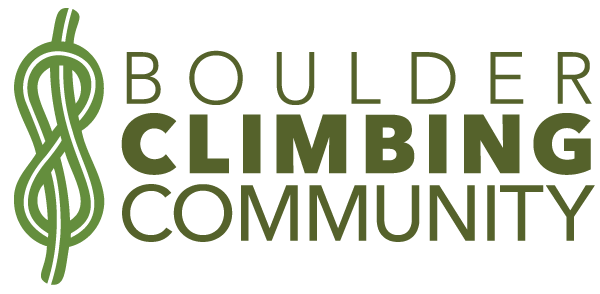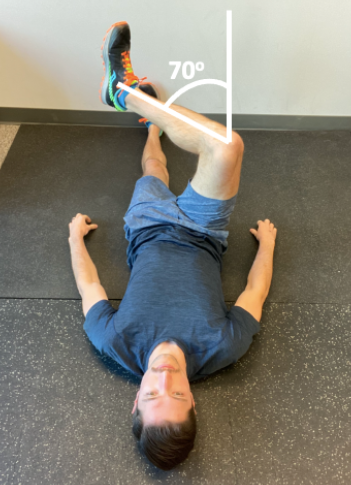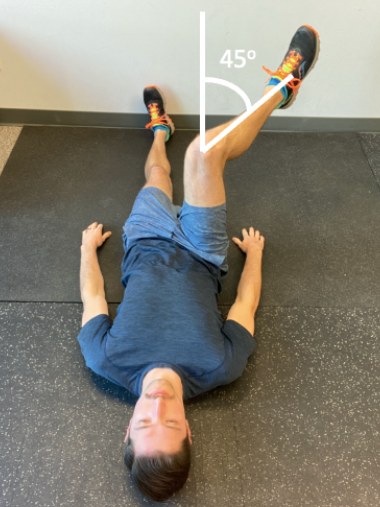Don't Let Hip Pain Stop You From Climbing!
Article by Dr. Evan Ingerson of BCC Partner Mend Physical Therapy
Hip pain and dysfunction is common in rock climbers. Learn about what causes hip pain and how you can fix it so you don’t have to miss a day of climbing.
As rock climbers, we tend to focus most of our training and injury prevention on the upper body. But as many of us have found, the lower body (especially the hip) can have significant impacts on our climbing injury risk and climbing performance. We have previously discussed how the hip can lead to upper body pain/dysfunction and in this article we’re going to learn more about the most common diagnosis affecting climbers’ hips: Femoroacetabular Impingement.
Femoroacetabular impingement (aka: FAI, hip impingement) is a common condition experienced by many rock climbers that is characterized by pain to the front of the hip or groin, experienced when the climber moves their hip toward the end of its range of motion.
The most common ways you will experience pain from hip impingement:
Lifting your knee to your chest: such as in a high step, perch, or high heel hook
Lifting your knee up and across your body: such as a through-flag or twisting your hip into the wall
Rotating your hip outward: “frog position” or getting your hips as close to the wall as possible with your leg at your side
With hip internal rotation: drop-knees.
Normal hip mobility is crucial for climbing performance and injury prevention. If you have normal hip mobility you should be able to”
Pull your knee all the way to your chest (with your knee bent)
Rotate your foot outward (hip internal rotation) to 45 degrees
Rotate your foot inward (hip external rotation) to over 70 degrees
Try this self assessment in the pictures below. To have adequate hip range of motion for rock climbing you should be able to:
Touch your thigh to your chest for high stepping. This should feel like a muscle stretch, rather than a pinch or hard ending to the movement.
70 degrees of hip external rotation so you can get your hips close into the wall.
45 degrees if hip internal rotation to be able to perform drop knees.
One of the trickiest aspects of reducing hip pain is that the presence of pain can directly cause impairments in the hip such as weakness or stiffness of the hip joint.
Pain can inhibit the activation of specific muscles such as the gluteus minimus and maximus.
Pain can also cause irritation of the joint structures, leading to decreased hip mobility.
Both of these impairments are also likely to cause increased pain.
Many people find themselves in this downward spiral of pain → dysfunction → pain
Pain and range of motion deficits from hip impingement can limit your climbing performance and limit your ability to climb overall. Many surgeons will recommend surgery as the first line treatment, especially if there is a cam lesion or pincer lesion present at the hip. But the research supports a different plan of treatment for rock climbers with this type of hip pain.
The rates of surgery for FAI/hip impingement have skyrocketed in recent years. Recent studies have shown that both Physical Therapy and surgery are effective at reducing pain and improving function in people with hip impingement. In our Boulder County Physical Therapy practice we have frequent conversations with patients about this evolving body of research and how it should guide their care.
Just recently, 3 meta-analyses (Gatz et al 2020, Bastos et al 2020, Dwyer et al 2020) were published with the aim of answering the question “is Physical Therapy or surgery more effective for femoroacetabular impingement?”. Depending on how you interpret the data, the answer remains unclear. Two of these analyses (Gatz and Dwyer) report better outcomes in patients undergoing surgery whereas Batos et al found no difference at 6, 12 and 24 months between physical therapy and surgery. The studies are riddled with limitations including:
Short term follow-up (longest 2 years)
Lack of description or consistency in “Physical Therapy” or whether Physical Therapy was consistent with current best evidence
No report of how the intervention impacted pain
Lack of meeting minimum clinically important differences in reported outcome measures (which essentially means the data showed a trend towards improvement, but those numbers might not have resulted in a noticeable change in function for subjects in the study!)
So, if you are experiencing symptoms related to hip impingement, where does this leave you?
There is strong evidence that BOTH Physical Therapy and surgery can help with symptoms and activity limitations related to hip impingement in younger active individuals without joint arthritis. At Mend, we recommend working with a physical therapist that can assess contributing factors to your symptoms and design an individualized program as your first line treatment option to get you back to rock climbing as quickly as possible. At Mend we commonly find impairments in both strength and mobility in patients with FAI and have excellent results with a multifaceted approach targeting these impairments. Surgery should be reserved for those individuals that do not achieve their goals with Physical Therapy until further data indicates the efficacy of one management strategy over another.
Should I get a cortisone injection for my hip?
FAI is the one of the fastest growing hip diagnoses due in part to greater utilization of imaging including MRI and more surgeons being trained in FAI procedures. Significant research questions remain in the diagnosis of FAI since many individuals without hip symptoms or loss of function demonstrate FAI and/or labral tears on imaging. In addition, the optimal treatment pathway is yet to be established to determine which patients require surgery and which will improve with conservative treatments including injections and Physical Therapy. To date, Physical Therapy remains the go to first line intervention for this condition for rock climbers and a recent review of the evidence documents which treatments are most effective for this condition.
Mallets and colleagues in the International Journal of Sports Physical Therapy reviewed the available evidence on outcomes after short term treatments for patients with impingement (2019). Authors included 7 studies on Physical Therapy or injections for this condition. They found conservative interventions such as activity modification, education, joint mobilizations and strength training are effective in the short term for reducing pain and improving function in this patient population. Physical Therapy exercise interventions demonstrated moderate to large effect sizes on pain and function. In comparison, joint injections alone demonstrated small to moderate effects on pain and function. The authors concluded Physical Therapy treatments “may hold more promise for recovery than joint injections alone.”
Mend Recommendation: since the outcomes look to be about the same either way, we strongly recommend doing 12 weeks of physical therapy prior to considering surgery.
What if I have a labrum tear in my hip?
As we have discussed in prior blogs on imaging of musculoskeletal conditions MRI tests are highly sensitive and can identify pathology in many patients with and without pain. This may lead to unnecessary and costly tests and procedures including surgery if the patient’s MRI is not accurately placed in the context of their clinical examination. These MRI changes are well established in pain free athletes including rock climbers and high level throwing athletes’ shoulders. A recent review of the medical literature reports on the high incidence of hip pathology in both asymptomatic and symptomatic athletes.
The journal Sports Medicine published a recent article on the prevalence of hip pathology in active athletes (Heerey et al. 2019). Consistent with prior research around half of all PAIN FREE athletes had a labral tear upon MRI testing. Hip cartilage defects were also prevalent in both groups, but identification of hip arthritis was rare. This study adds to our existing understanding on hip FAI and labral tears in asymptomatic athletes.
Mend Recommendation: work with your physical therapist to ensure your MRI findings are interpreted with your current injury history and clinical examination in order to receive the optimal treatment.
Should I do dry needling or injections for my hip pain?
Dry needling is an effective Physical Therapy intervention for the treatment of muscle pain and injury. Our previous post described a recent review article supporting its use for the reduction of short term pain and disability in multiple body parts including the spine and hip. A recent study compared the effects of dry needling and steroid injections for the treatment of hip pain. Brennan and colleagues in the Journal of Orthopedic and Sports Physical Therapy compared the effects of steroid injections to dry needling for patients with lateral hip pain (2017). 50 hips were randomized to one of the two treatments including either dry needling or steroid injection for up to 6 weeks based on provider choice. The study showed similar results between groups for either dry needling or steroid injection at short and long term follow up. The authors report dry needling is a viable treatment alternative for hip pain.
Mend Recommendation: dry needling is effective in the short term for hip pain and should be tried before a steroid injection.
If you have limitations in your hip range of motion or have pain in your hip when climbing, try the exercises below to both improve hip range of motion and don’t forget to strengthen your hips too. Don’t let your hips limit your climbing performance!
If you are interested in learning more about how to improve your climbing movement and how it could help you with injury prevention or recovery from a current climbing injury please contact Dr. Evan Ingerson at Mend Physical Therapy in Boulder at Evan@mendcolorado.com. Mend is a physical therapy and sports medicine clinic that treats all body regions and people of all athletic abilities, with a specialty in rock climbers and return to climbing programs.
Mend is committed to the health of climbers and our climbing areas and shares the vision of the Boulder Climbing Community. BCC members get their first appointment free and their second appointment 25% off!
Looking for more evidence-based content specifically for climbers? Visit the Mend rock climbing blog, the physical therapy for rock climbers home page, and you can sign up for monthly newsletters to receive the latest evidence-based content about climbing injury prevention, treatment, and training.





